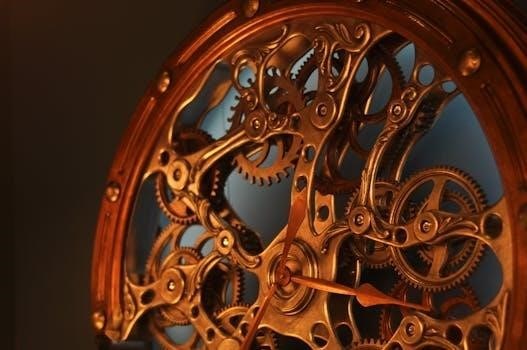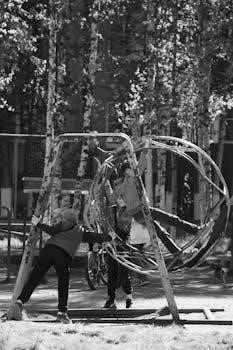The Wheel of Time Roleplaying Game, based on Robert Jordan’s novels, offers fans a unique way to immerse themselves in the rich world. It allows players to craft their own stories, recreating the adventure and wonder found within the books using dice, friends, and imagination.
Overview of the Wheel of Time RPG
The Wheel of Time RPG provides a platform for players to explore the world created by Robert Jordan, stepping into the shoes of characters within this epic fantasy setting. It allows for the creation of unique narratives, allowing players to experience the world’s complexities firsthand. The game originally saw a release under the d20 system by Wizards of the Coast, with only a core rulebook and one supplement published. Despite this, dedicated fans have continued the game’s legacy by producing netbooks and other PDF releases. The core gameplay focuses on recreating the atmosphere of the novels, presenting a world of adventure and wonder. Players can delve into various eras and locations of the Wheel of Time world, crafting their own unique stories in this rich and detailed setting. The game encourages both adventure and intrigue, aligning with the themes of the novels. It’s a chance to participate in the turning of the Wheel, impacting the fate of the world.

Game System and Editions
The Wheel of Time RPG has seen different system adaptations, including the Fuzion system and the d20 system by Wizards of the Coast. These varied systems offer different approaches to gameplay.
The Fuzion System Conversion
The Fuzion system conversion for the Wheel of Time RPG was a fan-driven effort, spearheaded by Mark Stout, Eric Foster, and Dawn Foster. This conversion sought to bring the epic scope of Robert Jordan’s novels to life using the Fuzion ruleset. The Fuzion system, known for its flexibility, allowed for a detailed representation of the diverse characters and abilities found in the Wheel of Time universe. This conversion offered an alternative to the more widely known d20 system, catering to players who preferred Fuzion’s mechanics and style. It allowed for a unique take on the setting, enabling different kinds of stories and character builds. The adaptation made possible role-playing experiences focusing on the nuances of the world rather than just combat, reflecting the complex narrative of the book series. The conversion involved a lot of creativity and dedication to the lore.
The d20 System and Wizards of the Coast
In 2001, Wizards of the Coast published the official Wheel of Time RPG using the d20 system, a system revolutionary for its time. This adaptation aimed to bring the world of Rand al’Thor to the tabletop. The core rulebook was released in October 2001, followed by a single supplement, “The Prophecies of the Dragon”. Despite the initial push, this was the only expansion ever published for the game. The d20 system, while popular, had its limitations, which, over time, have been addressed by newer editions. This system, using dice rolls for actions, focused on combat and character abilities, and the game attempted to capture the magic, intrigue, and epic scale of Jordan’s novels. It allowed players to create their own characters within the established setting and interact with the world.
Fan-Made Netbooks and PDF Releases
The limited official support for the Wheel of Time RPG spurred a dedicated community of fans to create their own supplementary materials. These fan-made netbooks and PDF releases have become a vital resource for players seeking additional content. These releases are often created with passion and care, expanding upon the core rules and lore of the game. These netbooks offer new character options, adventures, and insights into the world of the Wheel of Time, and many are freely available as PDF downloads. The creation of these resources often involves significant effort and collaboration within the fan community. This dedication ensures the game continues to be actively explored, even after the official support ceased. These netbooks are a testament to the lasting impact of Robert Jordan’s world.

Core Gameplay and Mechanics
Core gameplay revolves around character creation, skills, feats, and combat. The One Power magic system is a key element, allowing characters to wield unique abilities, shaping the game’s dynamic and narrative.
Character Creation and Abilities
Character creation in the Wheel of Time RPG involves defining a character’s core attributes. These attributes, such as Strength, Dexterity, and Intelligence, are modified by various factors, influencing a character’s overall capabilities. The game uses a system of temporary modifiers that can affect these core scores, reflecting the character’s current state or circumstances. Abilities are represented by these modified scores, which dictate actions in the game. Hit points (HP) and defense are also core parts of character creation, determining the ability of a character to withstand damage. Additional character abilities include skills, feats, and the potential to use the One Power, each adding to the complexity and depth of character design. The game is flexible enough to allow for unique and varied character builds. Initial creation lays the foundation for a character’s journey within the Wheel of Time world.
Skills, Feats and Combat
In the Wheel of Time RPG, skills and feats are essential components, adding depth and customization to characters. Skills represent a character’s learned abilities, while feats are special talents that enhance their capabilities. These skills and feats, along with base abilities, play a crucial role in determining the outcome of combat and other challenges. Combat is a core mechanic in the game, where players utilize their character’s skills and abilities to engage in tactical maneuvers. The combat system is designed to be engaging, incorporating dice rolls, modifiers, and strategic decision-making. It emphasizes the importance of character abilities and how they are applied during conflict. A successful combat encounter relies on a combination of character skills, tactical choices, and the application of feats in both offensive and defensive situations.
The One Power Magic System
The One Power magic system is a central element of the Wheel of Time RPG, reflecting the intricate nature of the magic in Robert Jordan’s novels. Channeling the One Power is not merely spell-casting; it’s a complex process that involves manipulating the True Source. Characters must carefully manage their connection to the Source, as overuse can lead to exhaustion and even madness. The system differentiates between the male and female halves of the One Power, saidar and saidin, each with unique properties and risks, creating diverse play styles. Weaving the Power requires skill, focus, and knowledge, and the effects of a weave are influenced by the character’s talent and the weave’s complexity. The One Power is a dynamic force that shapes the world, making it a powerful and pivotal aspect of gameplay.

Setting and Lore
The Wheel of Time RPG allows adventures in any era or region, often during the time of the Dragon Reborn. The game focuses on the rich lore, allowing players to explore the diverse world and its history.
Eras and Places of Play
The Wheel of Time Roleplaying Game provides a vast canvas for adventures, allowing players to set their campaigns in any era or region of the rich world created by Robert Jordan. Most campaigns will typically unfold during the pivotal period depicted in the novels, specifically when Rand al’Thor is revealed as the Dragon Reborn. This time is marked by significant events, where the fate of the entire world hangs in the balance. Players can explore various locations, from the Two Rivers to the White Tower, and even venture into the Blight. The flexibility of the game allows for stories set in the Age of Legends or other less explored eras. This freedom enables players to delve into the lore of the world and experience it from different perspectives, making each campaign a unique journey through the turning of the Wheel.
Monsters and Antagonists
The Wheel of Time RPG features a variety of monsters and antagonists that fit well within the storyline and the novels’ narrative. The gholam, a particularly nasty creation, stands out as a formidable foe. While the focus remains primarily on human versus human conflict, there are various other creatures that add depth to the game’s challenges. Introducing monsters thoughtfully is key to preventing boredom in combat-heavy adventures. This is essential, given the series’ core theme of human struggles and political intrigue as primary drivers. The game provides a selection of adversaries, ranging from Darkfriends to Shadowspawn, to ensure engaging and varied encounters, reflecting the dangerous world. Care must be taken to ensure that the encounters align with the overall narrative and enhance the gameplay experience.

Availability and Resources
Finding downloadable PDF files of the Wheel of Time RPG can be challenging, with some sources asking high prices. However, fan-made netbooks and online communities offer alternative resources and support.
Finding Downloadable PDF Files
Locating downloadable PDF files for the Wheel of Time RPG, especially the original core rulebook, can be a tricky endeavor. While some online vendors might list the books for sale, often at inflated prices, many fans seek free or more accessible options. The original d20 edition by Wizards of the Coast had limited official support, with only one supplement ever released, making it difficult to find legitimate digital copies. This scarcity has led to a reliance on fan-created content, which is often distributed as free PDFs. These include netbooks and other supplemental materials that help expand on the game. Unfortunately, the original rulebook itself remains elusive in digital format, with many fans expressing the desire to find a downloadable PDF version. The search often involves scouring forums, online archives, and fan communities hoping to unearth a free or reasonably priced copy. Be cautious when downloading files from unknown sources to avoid viruses or malware.
pdfFiller and Digital Document Management
pdfFiller emerges as a valuable tool for managing digital documents related to the Wheel of Time RPG, particularly those in PDF format. This service allows users to not only view and fill out PDF forms but also to edit and e-sign them. By adding the pdfFiller extension to your Chrome browser or using their app, you gain access to features that enhance document management. You can create legally-binding e-signatures by drawing, typing, or uploading images of your handwritten signature. This capability is particularly useful for handling character sheets, campaign notes, or other gaming-related documents. Furthermore, pdfFiller’s integration with Gmail allows for seamless document management directly from your inbox, streamlining the workflow. This eliminates time-consuming steps and enables effortless handling of PDFs. Using these digital tools enhances accessibility and usability of the game’s materials.
Community and Fan Support
The Wheel of Time RPG community is a vibrant and active group of fans who have contributed significantly to the game’s longevity. Despite the limited official releases, dedicated fans have created numerous netbooks and PDF releases to support the game. These fan-made resources are invaluable for players looking for new content and rules. The community’s efforts demonstrate a deep passion for the setting and the game system. Online forums and platforms are hubs for sharing these resources and fostering discussions about gameplay. This constant support ensures that the Wheel of Time RPG remains playable and relevant, even years after its initial publication. The collaborative nature of the community is a testament to the enduring appeal of Robert Jordan’s world. This collective effort is vital for keeping the spirit of the game alive.
